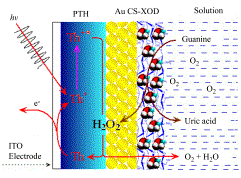| 1 Oliveira, A. M.; Vivan, M.; Fernandes, I. R. Talanta 2002,56, 959.2 Pedano, M. L.; Rivas, G. A. Electrochem. Commun. 2004, 6,10.3 Cai, X.; Rivas, G.; Farias, P. A. M.; Shiraishi, H.; Wang, J.; Palecek, E. Electroanalysis 1996, 8, 753.4 Brabec, V.; Dryhurst, G. J. Electroanal. Chem. 1978, 89,161.5 Marrazza, G.; Chianella, I.; Mascini, M. Anal. Chim. Acta1999, 387, 297.6 Wang, J.; Cai, X.; Tian, B.; Shiraishi, H. Analyst 1996, 121,965.7 Wang, J.; Kawde, A.-N. Anal. Chim. Acta 2001, 431, 219.8 Armistead, P. M.; Thorp, H. H. Anal. Chem. 2001, 73, 558.9 Rusling, J. F. Biosens. Bioelectron. 2004, 20, 1022.10 Wu, K.; Fei, J.; Bai, W.; Hu, S. Anal. Bioanal. Chem. 2003,376, 205.11 Wang, Z.; Zhao, Z. Chin. J. Anal. Chem. 2006, 34, 87 (in Chinese). (汪振辉, 赵志娟, 分析化学, 2006, 34, 87.)12 Jia, W.; Li, T.; Zhang, J.; Wang, H. Chem. J. Chin. Univ.2006, 27, 2056 (in Chinese). (贾文丽, 李天华, 张晶晶, 王怀生, 高等学校化学学报,2006, 27, 2056.)13 Abbaspour, A.; Mehrgardim, A. Anal. Chem. 2004, 76,5690.14 Liu, H.; Wang, G.; Chen, D.; Zhang, W.; Li, C.; Fang, B. Sens. Actuators, B 2008, 128, 414.15 Zhou, M.; Zhai, Y.; Dong, S. Anal. Chem. 2009, 81(14),5603.16 Zhang, W.; Yang, T.; Yin, C.; Li, G.; Jiao, K. Electrochem. Commun. 2009, 11, 783.17 Wang, G. L.; Xu, J. J.; Chen, H. Y. Sci. China, Ser. B-Chem.2009, 52, 1789.18 Zhao, C.; Yu, J.; Zhao, G.; Jiao, K. Scientia Sinica Chim.2011, 41, 1075 (in Chinese). (赵常志, 俞佳, 赵改爽, 焦奎, 中国科学化学, 2011, 41,1075.)19 Yang, W. W.; Li, Y. C.; Bai, Y.; Sun, C. Q. Sens. Actuators, B 2006, 115, 42.20 Yang, R.; Ruan, C.; Dai, W.; Deng, J. Electrochim. Acta1999, 44, 1585.21 Markas, A. T.; Gilmartin, J. P. H.; Birch, B. Analyst 1992,117, 1299.22 Ohe, T.; Watanabe, Y. J. Biochem. 1979, 86, 45. |
